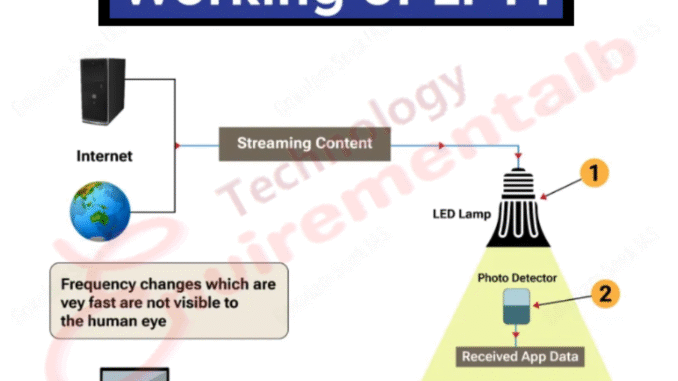
LiFi Data Transfer System: A visible light communication system transmitting wireless internet communications is a visible light communication system that transmits data at very high speeds. This technology makes an LED light bulb transmit pulses of light that are unseeable by the human eye, and within those emitted pulses, data can travel in both directions. The receivers absorb information and interpret the transmitted data. This is similar to decoding Morse code, but its speed is 1000 times faster. LiFi transmission speed may be 100 Gbps. Its speed is 14 times faster than WiGig and it is also known as the world’s fastest WiFi
In this project, we develop a data transfer system that uses LiFi technology. This project has the following features.
- No Wires Needed
- High-Speed Data Transfer
- Reliable Communication with No Data Loss
- Low Cost of Developing the System
This system consists of an LDR sensor along with an Atmega microcontroller, an LCD for display, a power supply, basic components, and a PCB for display. The system uses the LiFi communication medium for data transfer from transmitter to receiver. Android LiFi app we are using to demonstrate this system. This app encodes written text messages to light flash data.
On the transmitting side, the message app controls the mobile flashlight to transmit the message. The phone encodes the message into a series of flashes and transmits this message using the mobile torch light. As the flashlight falls on the LDR receiver, it decodes the message and sends it to the microcontroller for further processing. The ATmega microcontroller decodes the message and displays the message on the LCD.
Components Required for the LiFi Data Transfer System
- Cables and Connectors
- PCB Board
- Atmega 328 Controller
- Push Buttons
- LDR Sensor
- Regulator Circuitry
- Switches
- LED’s
- Capacitors
- Resistors
- Transistors
Block Diagram
The block diagram of the LiFi data transfer system is given below; it’s very clear and easy. Even a new student of electronics can understand this system.
WiFi (Wireless Fidelity) vs. LiFi (Light Fidelity)
Advantages
- LiFi: Minimum interference and can pass through salty water, works in almost every area
- WiFi: More interference than LiFi, cannot travel through seawater, only pass through less dense regions
Application
- LiFi: Used in undersea explorations, airlines, operation theaters and office and home premises for data transfer
- WiFi: Mostly used for internet browsing
Coverage distance
- LiFi: It can cover About 10 meters
- WiFi: it can cover About 32 meters, varies based on transmit power and antenna type
Data density
- LiFi: Works in high-density atmospheres/environments
- WiFi: Works in less dense atmospheres/environments because of interference-related issues
Interference
- LiFi: They don’t have any interference issues.
- WiFi: It uses several sources of radio interference that can become the cause of failure.
Privacy
- LiFi: I will provide more secure data transfer because wall can blocked light
- WiFi: WiFi signals cannot be blocked by walls so its less secure
Visit: Best Outdoor Wifi Extender

